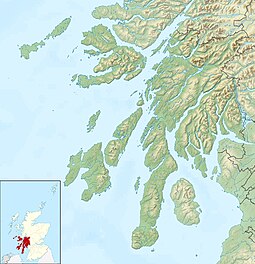Our website is made possible by displaying online advertisements to our visitors.
Please consider supporting us by disabling your ad blocker.
Staffa
| Scottish Gaelic name | Stafa |
|---|---|
| Old Norse name | stafi-oy |
| Meaning of name | Old Norse for 'stave or pillar island'. |
 Aerial view of Staffa, with The Colonnade in the foreground and Am Buchaille to the right | |
| Location | |
| OS grid reference | NM323355 |
| Coordinates | 56°26′N 6°20′W / 56.43°N 6.33°W |
| Physical geography | |
| Island group | Mull |
| Area | 33 ha (1⁄8 sq mi) |
| Area rank | 0 [1] |
| Highest elevation | 42 m (138 ft) |
| Administration | |
| Council area | Argyll and Bute |
| Country | Scotland |
| Sovereign state | United Kingdom |
| Demographics | |
| Population | Uninhabited since 1800 |
| References | [2][3][4] |
Staffa (Scottish Gaelic: Stafa,[4][5] pronounced [ˈs̪t̪afa], from the Old Norse for stave or pillar island) is an island of the Inner Hebrides in Argyll and Bute, Scotland. The Vikings gave it this name as its columnar basalt reminded them of their houses, which were built from vertically placed tree-logs.[6]
Staffa lies about 10 kilometres (6 miles) west of the Isle of Mull; its area is 33 hectares (82 acres)[7] and the highest point is 42 metres (138 feet) above sea level.
The island came to prominence in the late 18th century after a visit by Sir Joseph Banks. He and his fellow-travellers extolled the natural beauty of the basalt columns in general and of the island's main sea cavern, which Banks renamed 'Fingal's Cave'. Their visit was followed by those of many other prominent personalities throughout the next two centuries, including Queen Victoria and Felix Mendelssohn. The latter's Hebrides Overture brought further fame to the island, which was by then uninhabited. It is now in the care of the National Trust for Scotland.[8]
- ^ Area and population ranks: there are c. 300 islands over 20 ha in extent and 93 permanently inhabited islands were listed in the 2011 census.
- ^ Haswell-Smith (2004) pp. 124–27
- ^ Ordnance Survey 1:50,000 First Series (1976) Sheet 48
- ^ a b Mac an Tàilleir, Iain (2003) Ainmean-àite/Placenames. (pdf) Pàrlamaid na h-Alba. Retrieved 26 August 2012.
- ^ "Staffa". Sabhal Mòr Ostaig. Retrieved 25 August 2020.
- ^ Murray (1973) p. 44
- ^ This is Haswell-Smith's estimate. Keay (1994) states 28 hectares (69 acres).
- ^ Cite error: The named reference
Keaywas invoked but never defined (see the help page).
Previous Page Next Page



